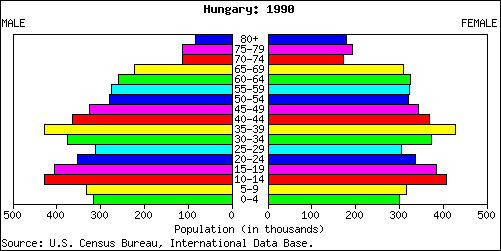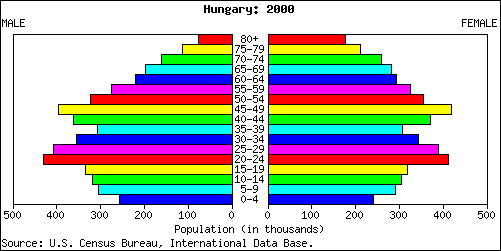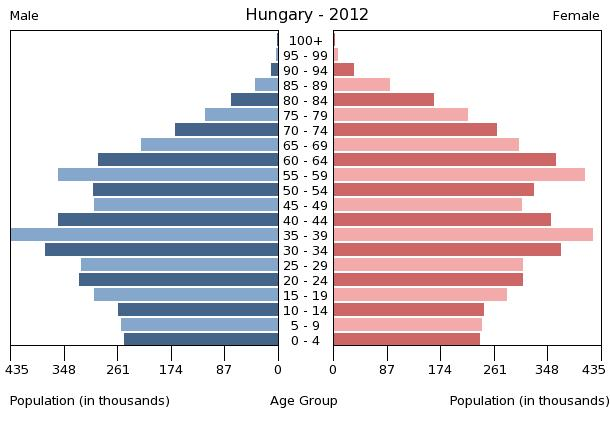Introduction
The demographics of a country are very significant as they determine various aspects of the economy. The working force of the country is determined by the general population set up. A large population means that the domestic level of consumption is high. It could also imply a large workforce that could spur the economic growth of a country.
On the contrary, high levels of unemployment in an economy that has a large population means that the level of production is low in the country. This paper discusses the demographics of Hungary’s population. It will also highlight the demographic policies set up by the Hungarian government to check population demographics.
Country Demographics: Hungary
The general population of Hungary is comprised of Hungarians, who form 92.3% of the population. Therefore, the national language spoken in the country is also Hungarian. About half of the Hungarians are Catholics by religion while the rest are Calvinists, Lutherans, Greek Catholics or other Christians. According to The World Factbook, the country’s population estimates are 9,958,453 people (par. 3). Compared to the world, the country is ranked 87 with regard to the total population.
The population of Hungary is comprised of different age groups. The 0-14 year group and the 15-24 year group form 14.9% and 12.1% of the total population respectively. Majority of the people are aged 25-54, which forms 41.7% of the population. The aging groups of 55-64 and people above 65 years of age form 14.2% and 17.1% of the country’s total population respectively. This is depicted in the pyramid below (“The World Factbook: Hungary” par. 3).

With a median age of 40.5 years, the growth of the population is -0.184. The comparison of Hungary to the rest of the world based on the population growth rate shows that the country is ranked 206. The negative growth rate implies that given time, the country’s population is decreasing.
This could be attributed to the low birth rate of 9.49 births among 1000 people as compared to a high death rate of 12.7 deaths among 1000 people. Out of the entire population in the country, 68% of the population lives in cities (“The World Factbook: Hungary” par. 3).
Maternal mortality rate is a significant demographic factor that has some economic significance with the rate being 21 deaths in 1000 births. This level is quite high when compared to other countries in the world where Hungary is ranked 137. The maternal mortality rate could be one of the factors for high mortality rate as compared to low birth rate. Although infant mortality rate is not very high, 5.24 deaths occur in every 1000 live births (Burns and Cekota 74).
Life expectancy is an important measure of the welfare of a population. The life expectancy in Hungary is 75.02 years at birth with females having a higher life expectancy of 78.98 years compared to males who have 71.27 years. Health expenditure by the Hungarian government is 8.2% of the GDP. Under this measure, Hungary is ranked 53 across the world.
However, if the expenditure on health can be increased to reduce the mortality rates, the population growth would be positive. According to Moniq (223), the health of the working force of a nation is very significant as it determines the level of productivity of the labor force. Consequently, the level of HIV infection in Hungary is very low at 0.1% with only 3,000 people living with HIV/AIDS.
Literacy levels in the population of Hungary stands at 99% with every person aged 15 years and above can read and write effectively. This could be due to high expenditures of the Hungarian government on education, which is 5.2% of the GDP and is ranked 52 when compared with other countries in the world.
Despite the high literacy levels, a good number of the population is unemployed. The level of unemployment in Hungary is 26.5%, which makes the country ranked as 22 when compared with other countries across the globe. This is a very high rate.
Demographic Change over Time
The population of Hungary has been on the decrease over time mainly due to various factors. To begin with, the birth rate is quite low among the citizens of Hungary. This could also be as a result of the high number of mortality rates as compared to the birthrates. The comparison of the population pyramids of Hungary since the year 2000 to 2012 reveals that the age structures have changed.
While initial pyramids indicate large numbers of people at the top age groups such as those aged above 65 years of age, later pyramids such as that of 2000 and 2012 show reduced number of the aged population. The middle age groups’ demographic composition of the Hungary population has not changed much. However, it is clear that the mortality rate of females aged above 65 years is lower than that of their male counterparts given that there are more females in that age bracket than males.


(“Hungary Population Pyramid for 1990” par. 1).

Demographic Policy options for Hungary
Demographic policies are significant to any economy including Hungary. The population of Hungary began exhibiting a decrease that began in 1980. From the demographic pyramid shown above, it is clear that the country’s population has been decreasing since.
The decrease has been accompanied by decreasing fertility rates too. This has resulted in high death rates as compared to the birth rates and consequently the decreasing population. Due to these changes, the Hungarian government initiated some policies to overcome the population demographic changes (László 53).
The policies adopted by the government of Hungary can be traced back many years even before the Second World War. However, more policies have been implemented by the government with regard to population growth. From 1990 to 1994, the government of Hungary adopted a population resolution 1994 in whose decrees were not implemented. It further went ahead to establish a family policy between 1994 and 1998 where the policy shifted toward poverty allowance systems.
The government went further to establish policies on family planning that could help it maintain a steady increase in the population growth, especially after realizing the continued population decrease. The policies had various measures to hinder acceleration of the aging process in the population while promoting the economic progress of the country (Demographic Policy 5).
Conclusion
Despite the efforts of the Hungarian government to put in place demographic policies, it has faced challenges concerning implementing the policies. One of the challenges has been inadequate financing of the policies thereby making the policies to be less effective. Despite the challenges, the Hungarian government has established institutions that support the family, especially the mother and the child.
This has included maternity allowance, childbirth leave, and additional leaves for child growth. Other programmes were initiated for different purposes towards population control. For instance, the government established a policy on abortion where abortion could only be undertaken under certain limits. Additionally, a policy relating to the state of the health of the country’s population and mortality was established with the aim being ensuring a healthy working labor force.
Works Cited
Demographic Policy 2013, National Report of Hungary. PDF File. Web.
Burns, Andrew and Cekota, Jaromir. “Coping with Population Ageing in Hungary.” OECD Economic Department Working Papers. No. 338. 2002. Print.
Moniq, Kaposztaz. “Demographic situation and population policy in Hungary.” Demographics 29.3 (1987): 217-227.
László, Hablicsek. “Demographic Situation and Population Policies in Hungary.” In: Tomáš Kučera. New Demographic Faces of Europe. Berlin Heidelberg: Springer-Verlag, 2000. Print.
Hungary Population Pyramid for 1990 2013. Web.
The World Factbook: Hungary 2013. Web.